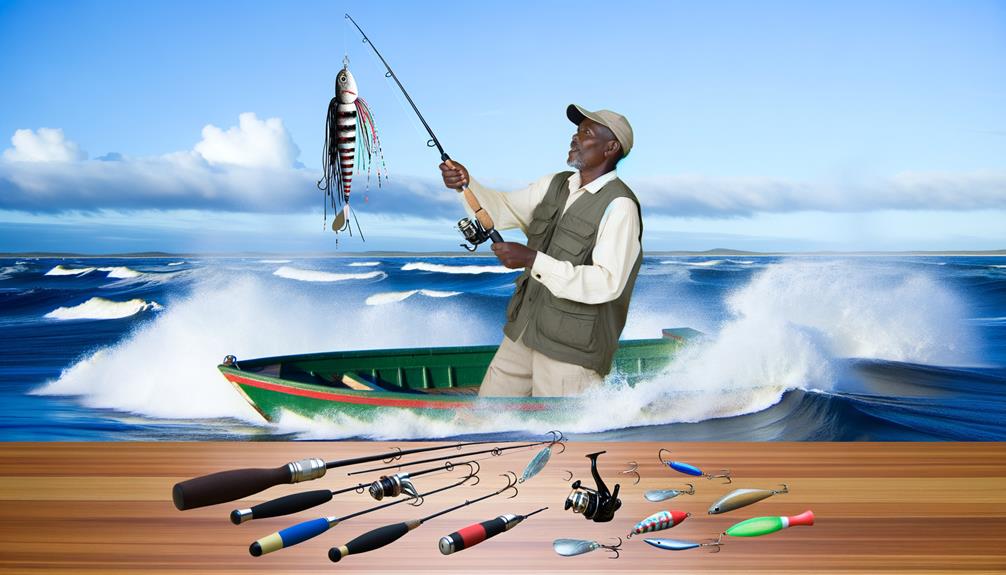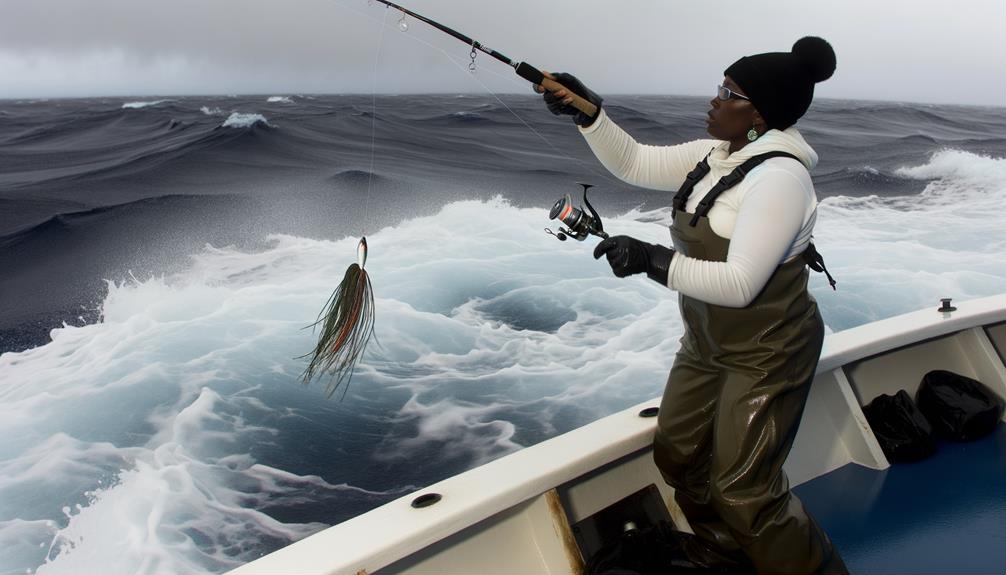Bucktail jigs, with their versatility and effectiveness, have become an indispensable tool in the arsenal of saltwater anglers. These lures, when deployed correctly, can incite strikes from a wide array of species, making them a popular choice among seasoned fishermen.
But how does one maximize the potential of a bucktail jig in a saltwater environment? This involves a precise blend of selecting the appropriate jig, mastering the casting and retrieval techniques, and understanding the behavior of the targeted species.
The ensuing discussion will elucidate these aspects in detail, offering insights that could potentially enhance your angling experience.
Key Takeaways
- Understanding the versatility and appeal of bucktail jigs is crucial for successful saltwater fishing.
- Choosing the right bucktail jig involves considering weight, design, construction quality, and the targeted species.
- The selection of color and material of the jig is influenced by water clarity and the need for durability and lifelike movement.
- Mastery of jigging techniques, adapting to fish behavior, and practicing catch-and-release ensures sustainable and effective fishing.
Understanding the Bucktail Jig
To effectively utilize a bucktail jig in saltwater fishing, one must first comprehend its unique characteristics including its diverse sizes, colors, and the strategic use of deer tail hair that creates a lifelike movement in the water, attracting various species of fish. This fishing technique leverages the jig's versatility and resemblance to natural prey, making it a potent lure in the angler's arsenal.
Bucktail jigs come in an array of sizes and colors, each designed to match different fishing conditions and target species. The varying sizes influence the depth at which you can fish the bucktail, while the colors can be selected to mirror the appearance of local baitfish or stand out in murky waters.
The true magic of a bucktail jig, however, lies in the deer tail hair. The hair pulsates in the water, mimicking the movements of live prey, thereby luring fish towards it. Adding a trailer, like plastics or pork rind, enhances the jig's appeal, enticing more and bigger bites. Understanding these different types and features of a bucktail jig is a crucial first step to mastering this effective lure, setting the foundation for successful saltwater fishing.
Choosing Your Bucktail Jig
When choosing your bucktail jig for saltwater fishing, several key factors should be taken into account. These include the weight of the jig, which should be selected based on the depth of the water and the speed of the current.
The realism of the eye design can significantly impact your success. The color of your jig should be chosen in accordance with water clarity and light conditions. Quality hooks and durable construction are crucial for dealing with strong saltwater fish.
Selecting Jig Size
In the realm of saltwater fishing, selecting the correct size of your bucktail jig, ranging from 1/4 to 3 ounces, is crucial and largely depends on factors such as the depth of the water and the target species. The table below provides a simplified guide for choosing jig sizes based on water depth, target species, and fishing conditions.
| Jig Size (oz) | Water Depth (ft) | Target Species |
|---|---|---|
| 1/4 – 1 | 0 – 30 | Small baitfish |
| 1 – 3 | 30 – 100+ | Squid or large prey |
| Micro (~1/8) | Backwaters/Estuaries | Small critters |
Lighter bucktail jigs are ideal for shallow waters and small baitfish imitation, while heavier jigs work well in deep water and fast currents, imitating squid or larger prey. Micro jigs are perfect for quiet backwaters and estuaries. Always match your jig size to the fishing conditions for optimal results.
Color and Material Considerations
Choosing the right color and material for your bucktail jig plays an integral role in its effectiveness in saltwater environments. A few key points to consider when choosing your bucktail jig include:
- Select natural colors such as white, chartreuse, or olive to effectively simulate baitfish in the water.
- Consider water clarity. Brighter colors work well in murky water, while natural tones are more effective in clear water.
- Opt for high-quality materials to ensure the durability of your jig and its lifelike movement in the water.
Ideal Locations for Bucktail Jigging

For optimal results with bucktail jigging in saltwater, consider locations such as rocky areas, reefs, drop-offs, and underwater structures where fish tend to take refuge. These locations provide the perfect environment for executing effective saltwater fishing tactics, with bucktail jigs being a popular choice due to their versatility and broad appeal to a variety of fish species.
Bucktail jigs excel in areas with strong currents or tidal flows. Their unique design allows them to maintain stability, making them ideal for white-water surf, especially in shallow rocky areas where fish are most active. Fishing near weed beds, docks, piers, and bridges also proves to be successful, as these structures provide a sanctuary for fish, making them prime spots for jigging.
In addition to these, back bays and estuaries serve as fantastic locations for bucktail jigging. These areas often feature varying depths, presenting opportunities for targeting different species. A well-placed bucktail jig can entice a strike from saltwater gamefish that are drawn to the lure's lifelike movement. Ultimately, understanding where to fish is just as crucial as knowing how to fish when it comes to bucktail jigging.
Essential Bucktail Jigging Gear
The selection and maintenance of your bucktail jigging gear are fundamental to successful saltwater fishing. Appropriate equipment, including the right rod, reel, line, and jigs, can significantly enhance your fishing performance and experience.
Furthermore, understanding the basics of gear maintenance not only extends the lifespan of your equipment, but also ensures its optimal function during every fishing trip.
Selecting Your Jigging Equipment
When it comes to successful bucktail jigging in saltwater, selecting the right equipment is a crucial first step. Your rod selection should be a medium to medium-heavy spinning rod, ideally 7-8 feet in length. This will provide optimal performance when jigging.
Equally important is your reel choice. Pair your rod with a quality spinning reel, capable of holding 150-200 yards of 20-30 lb braided line.
In terms of terminal tackle:
- Opt for a fluorocarbon leader of 20-30 lb test, providing abrasion resistance and stealth in clear water conditions.
- Select bucktail jigs in various weights from 1/4 to 3 ounces.
- Ensure you have a variety of trailer options like soft plastics or pork rind to enhance the jig's action.
This will effectively cover different water depths and currents, attracting more fish.
Understanding Gear Maintenance
Maintaining your bucktail jigging gear is an essential task that ensures its longevity and performance in saltwater environments. Regular inspection and cleaning are critical. Check your bucktail jig for signs of rust and corrosion, replacing any damaged hooks promptly.
Implementing rust prevention measures, such as using a rust inhibitor or lubricant, can prolong the life of your gear. Tackle box organization is also crucial. By keeping your gear in a dry, structured space, you prevent tangling and maintain its quality.
Lastly, after each saltwater outing, rinse your bucktail jig with freshwater. This saltwater rinse removes any salt and debris, preventing deterioration and maintaining optimal performance for your next fishing adventure.
Mastering Jigging Techniques

To effectively master the art of jigging, it is essential to vary your retrieval speed, employ erratic movements, and experiment with different jigging motions to attract strikes successfully. With this, you can enhance your chances of attracting fish species in diverse saltwater environments.
Vertical jigging is a key technique to apply. It involves allowing your bucktail jig to sink and then jigging it upwards with sharp, swift movements. This is a proven method to trigger predatory responses, especially when the jig is close to the bottom. Keeping your bucktail jig near the seabed targets species that feed in these areas, thus maximizing your chances of hooking fish.
The use of braided line for jigging is highly recommended. It provides improved control and sensitivity, enabling you to feel subtle bites and make precise adjustments to your technique.
As part of mastering your jigging techniques, consider these pointers:
- Vary retrieval speed and employ erratic movements
- Keep your jig close to the bottom
- Use braided line for better control and sensitivity
Detecting and Responding to Bites
Detecting a bite while jigging a bucktail in saltwater often comes down to feeling a subtle tap or noticing a change in weight on the line. This shift can be as slight as a feather's touch, requiring your utmost attention to detect bites. A lighter line is often recommended to maintain this sensitivity, as it allows you to feel even the weakest nibble.
In addition to feeling for bites, it's important to watch for any unusual line movement or slack. This could indicate that a fish has taken your bucktail jig. If you notice any of these signs, respond quickly. Time is of the essence in these situations.
Setting the hook is a critical step when you detect a bite. A firm, upward motion is generally advised to secure the fish. However, understanding that not all bites are the same is key to successful hook-setting. Some fish might bite softly, while others hit hard. Thus, practicing different hook-setting techniques will help you adapt to varying bite strengths.
In the realm of saltwater fishing with a bucktail jig, detecting and responding to bites effectively is a skill that sets successful anglers apart. It's a game of patience, observation, and swift, precise action.
Advanced Bucktail Jigging Tips

When seeking to elevate your saltwater fishing game with a bucktail jig, it's beneficial to experiment with different jig weights and sizes to match the fishing conditions and target species effectively. Mastering the art of bucktail jigging isn't just about the jig itself, it's about the entire presentation.
To enhance your results, consider these advanced jigging tips:
- Incorporate trailers like soft plastics or pork rind to improve the jig's action and make it more inviting to saltwater species.
- Vary your retrieval speeds and jigging motions. Changing depths can also entice more strikes.
- Fish near underwater structures, such as rocks or areas with strong currents. These spots are often hideouts for many species.
Remember, effective jigging isn't about a single technique. It's about adapting to the environment and the behavior of the fish.
And finally, let's not forget the importance of catch-and-release. This practice helps ensure sustainable fishing for future generations. As responsible anglers, it's our duty to preserve the delicate balance of our saltwater ecosystems. So, let's keep learning, keep fishing, and most importantly, keep respecting our marine life.
Frequently Asked Questions
How Do You Fish a Bucktail Jig From the Beach?
To fish a bucktail jig from the beach, select appropriate equipment and apply beach casting techniques. Consider tide influence, seasonal variations, and jig color selection to enhance your chances of success. Practice makes perfect.
How Do You Fish a Jig in Saltwater?
Fishing a jig in saltwater involves careful selection of jig size and colors, targeting specific species, refining jigging techniques, overcoming challenges like currents and depths, and using appropriate equipment for successful jigging.
How Do You Rig a Bucktail?
Rigging a bucktail involves proper bucktail maintenance and selection of knot. Choose from different bucktail varieties based on ideal conditions. Use effective rigging techniques to secure the jig for optimal performance and attractive action.
What Fish Can You Catch With Bucktail Jig?
With bucktail jigs, anglers can catch various fish species. The jig colors, sizes, materials, and specific jigging techniques influence catches. Implementing seasonal fishing strategies increases success. Predatory fish species are particularly attracted to bucktail jigs.
Conclusion
In summary, the art of fishing a bucktail jig in saltwater is a multifaceted process requiring a profound understanding of the jig, strategic location selection, appropriate gear, and mastery of jigging techniques.
The ability to detect and respond to bites is paramount, and advanced skills further enhance success.
Like a seasoned chess player strategically moving pieces, an angler likewise manipulates the jig, maneuvering it through the aquatic battlefield to outwit elusive prey, demonstrating the versatility and efficacy of the bucktail jig.


